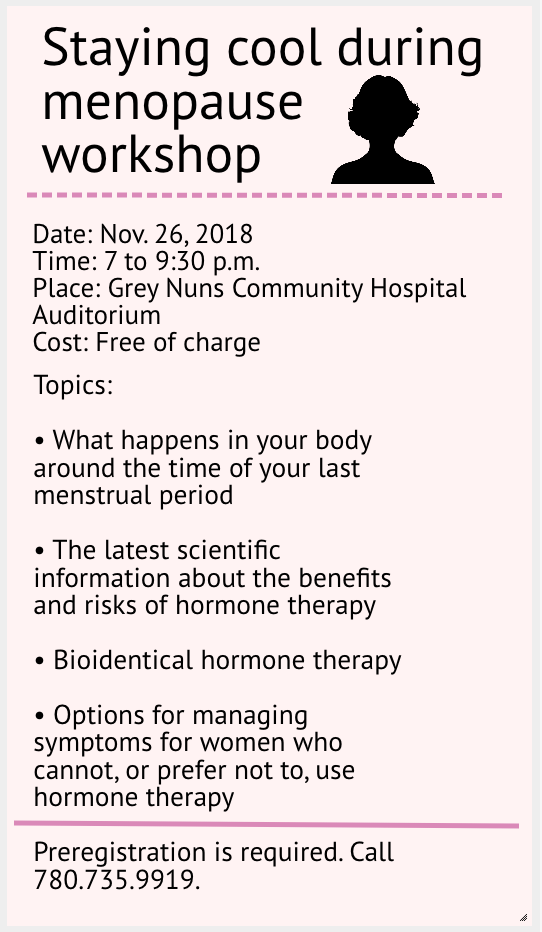Too few women know the facts about menopause
Free seminars provide insight on symptoms and treatment options

October 30, 2018
By Marguerite Watson, Senior Communications Advisor, Covenant Health
Menopause. Every woman experiences it, but too few women understand it.
Shelly Hagen and Lori Reich-Smith, both educators with the Women’s Wellness Clinic at the Grey Nuns Community Hospital, help close the information gap through free evening seminars held at the clinic. Women come from as far away as Camrose and Whitecourt to learn about symptoms and options for relief.
“Women want to understand the changes happening to them so they can make informed choices that help them live well through the transition,” says Shelly.
Many women don’t realize menopause is a major upheaval in the body that can last for five to 10 years, or even longer. And there’s a wide array of symptoms that can shift and vary in intensity over time.
In fact, researchers have identified up to 37 different symptoms, but they disagree about which symptoms are hormonal (due to menopause) and which are related to life circumstances, aging or general stressors. Only two symptoms—hot flashes and vaginal dryness—are 100 per cent connected to menopause.
The difference in opinion among researchers leaves women searching through conflicting information for answers to symptoms that sometimes seriously affect their quality of life. It’s a situation that’s made worse if they have a complicated medical history.
“About one in five [women] has a very difficult time,” Shelly says. For those who are struggling, it can take some detective work to sort out the causes and find the best options for managing their symptoms.
Though hormone therapy is still considered the most effective treatment for women who have more severe symptoms, many women worry that using it will increase their risk of breast cancer. If you look at the research, the risk does slightly increase with long-term use, say Lori and Shelly. In a population of 1,000 women aged 50-70, 45 women will be diagnosed with breast cancer each year. That’s the baseline risk. By comparison, an extra two women will be diagnosed with breast cancer annually in a population of 1,000 women (in the same age group) who’ve used hormone therapy for up to five years. The risk increases to an extra six women in 1,000 for up to 10 years of hormone therapy use and to an extra 12 women in 1,000 for up to 15 years of use.
It’s up to each woman to weigh her personal risks and benefits and decide what’s right for her, Shelly says.
Women who can’t, or prefer not to, use hormone therapy can sometimes get relief through non-hormonal treatment options. Taken at a low dose, certain antidepressants can ease hot flashes and night sweats. And medicines such as clonidine and gabapentin, as well as some over-the-counter products like black cohosh, can provide relief depending on the severity of the symptoms. As with any treatment, it’s important to check with a physician whether using over-the-counter products will conflict with taking other medications.

Making lifestyle or environmental changes—like avoiding caffeine, alcohol and spicy foods; dressing in layers; lowering the thermostat; using ceiling and floor fans; and practising stress reduction techniques—can also help women manage their symptoms.
“There are no cookie-cutter approaches,” says Lori. “Women are looking for ways to cope, and we’re here to support them through their journey with evidence-based information.”